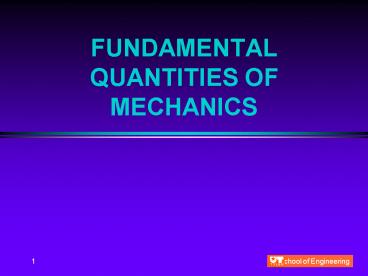FUNDAMENTAL QUANTITIES OF MECHANICS - PowerPoint PPT Presentation
1 / 16
Title:
FUNDAMENTAL QUANTITIES OF MECHANICS
Description:
periodic vibrations of isotope cessium 133 (an atomic clock) School of Engineering ... gravity, magnetism, atomic. School of Engineering. Newton's Laws of Motion ... – PowerPoint PPT presentation
Number of Views:2678
Avg rating:5.0/5.0
Title: FUNDAMENTAL QUANTITIES OF MECHANICS
1
FUNDAMENTAL QUANTITIES OF MECHANICS
2
Fundamental Quantities
- Space
- Time
- Matter
- Force
3
Fundamental Quantities
- Space
- geometric region in which the physical events of
interest in mechanics occur - region extends without limit in all directions
- points in space can be determined relative to
some reference system - types of reference systems
- inertial
- relative
4
Fundamental Quantities
- Time
- an interval between two events
- measurements
- solar year time for earth to orbit the sun
- periodic vibrations of isotope cessium 133 (an
atomic clock)
5
Fundamental Quantities
- Matter
- any substance that occupies space
- body matter bounded by closed surface
- inertia property of a body that causes it to
resist change in motion - mass quantitative measure of inertia
6
Fundamental Quantities
- Force
- the action of one body on another
- contact forces a push or pull directly on a body
- levers, rods, cables
- bodies at a distance forces of attraction or
repulsion - gravity, magnetism, atomic
7
Newtons Laws of Motion
- 1st Law A particle originally at rest will
remain at rest a particle originally moving with
a constant velocity will continue to move with a
constant velocity along a straight line, unless
the particle is acted on by an unbalanced force.
8
Newtons Laws of Motion
- 2nd Law When a particle is acted on by an
unbalanced force, the particle will be
accelerated in the direction of the force the
magnitude of the acceleration will be
proportional to the force and inversely
proportional to the mass of the particle.
9
Newtons Laws of Motion
- 3rd Law For every action there is an equal and
opposite reaction. The forces of action and
reaction between two contacting bodies are equal
in magnitude, opposite in direction, and
collinear.
10
Bodies
- Particle
- an object whose size and shape can be ignored
when studying its motion (or lack of motion) - only the position of the mass center of the
particle need be considered - orientation, rotation, and size play no role in
describing the motion of the particle
11
Bodies
- System of Particles
- two or more particles making up the object of
interest - the distance between centers of mass of the
individual particles may change with time or space
12
Bodies
- Rigid Body
- a system of many (infinite number?) particles in
which the relative position of the particles
comprising the body remain constant at all times
and under all loads - the size and shape of the body remain constant
13
Bodies
- Deformable Body
- a system of many (infinite number?) particles in
which the relative position of the particles
comprising the body does not remain constant at
all times and under all loads - the size and shape of the body change under load
14
Mass / Weight
- Mass of a body
- an absolute quantity, independent of the position
of the body and independent of the surroundings
in which the body is placed - Weight of a body
- the gravitational attraction exerted on the body
by another massive body (the earth, the moon,
etc.)
15
Mass / Weight
m1
Fg
r
Fg
m2
16
- End






























